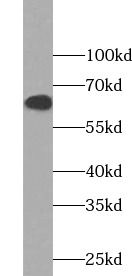Products
RELB antibody
Category:
Research Area:
- SPECIFICATIONS
- Product Name
- RELB antibody
- Catalogue No.
- FNab07234
- Size
- 100μg
- Form
- liquid
- Purification
- Immunogen affinity purified
- Purity
- ≥95% as determined by SDS-PAGE
- Clonality
- polyclonal
- Isotype
- IgG
- Storage
- PBS with 0.02% sodium azide and 50% glycerol pH 7.3, -20℃ for 12 months(Avoid repeated freeze / thaw cycles.)
Immunogen
- Immunogen
- v-rel reticuloendotheliosis viral oncogene homolog B
- UniProt ID
- Q01201
- Observed MW
- 62kDa
Application
- Tested Applications
- ELISA, IF, IHC, IP, WB
- Recommended dilution
- WB: 1:500-1:5000; IP: 1:200-1:1000; IHC: 1:20-1:200; IF: 1:10-1:100
Validated Images
 Raji cells were subjected to SDS PAGE followed by western blot with FNab07234(RELB Antibody) at dilution of 1:1000
Raji cells were subjected to SDS PAGE followed by western blot with FNab07234(RELB Antibody) at dilution of 1:1000
 IP Result of anti-RELB (IP:FNab07234, 3ug; Detection:FNab07234 1:300) with Raji cells lysate 2500ug.
IP Result of anti-RELB (IP:FNab07234, 3ug; Detection:FNab07234 1:300) with Raji cells lysate 2500ug.
 Immunohistochemistry of paraffin-embedded human colon cancer tissue slide using FNab07234(RELB Antibody) at dilution of 1:50
Immunohistochemistry of paraffin-embedded human colon cancer tissue slide using FNab07234(RELB Antibody) at dilution of 1:50
 Immunofluorescent analysis of HeLa cells using FNab07234 (RELB Antibody) at dilution of 1:25 and Rhodamine-Goat anti-Rabbit IgG
Immunofluorescent analysis of HeLa cells using FNab07234 (RELB Antibody) at dilution of 1:25 and Rhodamine-Goat anti-Rabbit IgG
- Background
- NF-kappa-B is a pleiotropic transcription factor which is present in almost all cell types and is involved in many biological processed such as inflammation, immunity, differentiation, cell growth, tumorigenesis and apoptosis. NF-kappa-B is a homo-or heterodimeric complex formed by the Rel-like domain-containing proteins RELA/p65, RELB, NFKB1/p105, NFKB1/p50, REL and NFKB2/p52. The dimers bind at kappa-B sites in the DNA of their target genes and the individual dimers have distinct preferences for different kappa-B sites that they can bind with distinguishable affinity and specificity. Different dimer combinations act as transcriptional activators or repressors, respectively. NF-kappa-B is controlled by various mechanisms of post-translational modification and subcellular compartmentalization as well as by interactions with other cofactors or corepressors. NF-kappa-B complexes are held in the cytoplasm in an inactive state complexed with members of the NF-kappa-B inhibitor(I-kappa-B) family. In a conventional activation pathway, I-kappa-B is phosphorylated by I-kappa-B kinases(IKKs) in response to different activators, subsequently degraded thus liberating the active NF-kappa-B complex which translocates to the nucleus. NF-kappa-B heterodimeric RelB-p50 and RelB-p52 complexes are transcriptional activators. RELB neither associates with DNA nor with RELA/p65 or REL. Stimulates promoter activity in the presence of NFKB2/p49. As a member of the NUPR1/RELB/IER3 survival pathway, may provide pancreatic ductal adenocarcinoma with remarkable resistance to cell stress, such as starvation or gemcitabine treatment. Regulates the circadian clock by repressing the transcriptional activator activity of the CLOCK-ARNTL/BMAL1 heterodimer in a CRY1/CRY2 independent manner. Increased repression of the heterodimer is seen in the presence of NFKB2/p52.



